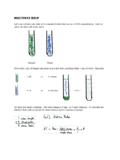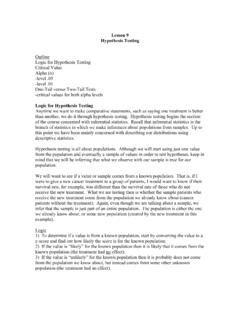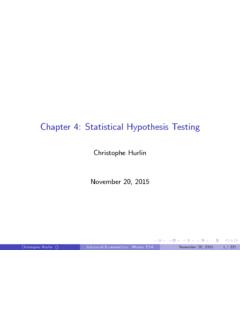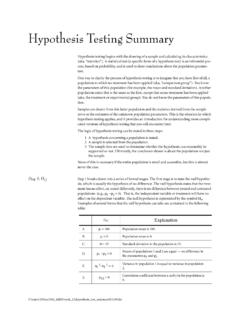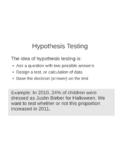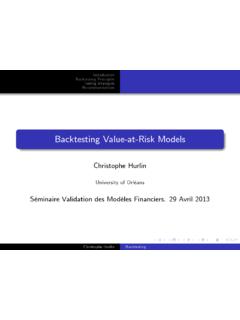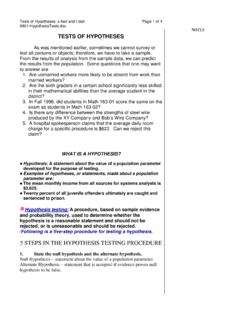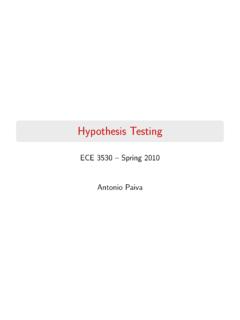Transcription of Contents
1 Contents10 Chi Square Introduction .. The Chi Square Distribution .. Goodness of Fit Test .. Chi Square Test for Independence .. Statistical Relationships and Association .. A Test for Independence .. Notation for the Test of Independence .. Reporting Chi Square tests for Independence .. Test of Independence from an SPSS Program .. Summary .. Conclusion .. 764702 Chapter 10 Chi Square IntroductionThe statistical inference of the last three chapters has concentrated on statis-tics such as the mean and the proportion. These summary statistics havebeen used to obtain interval estimates and test hypotheses concerning popu-lation parameters. This chapter changes the approach to inferential statisticssomewhat by examining whole distributions, and the relationship betweentwo distributions. In doing this, the data is not summarized into a singlemeasure such as the mean, standard deviation or proportion.
2 The whole dis-tribution of the variable is examined, and inferences concerning the natureof the distribution are this chapter, these inferences are drawn using the chi square distribu-tion and the chi square test. The first type of chi square test is the goodnessof fit test. This is a test which makes a statement or claim concerning thenature of the distribution for the whole population. The data in the sam-ple is examined in order to see whether this distribution is consistent withthe hypothesized distribution of the population or not. One way in whichthe chi square goodness of fit test can be used is to examine how closelya sample matches a population. In Chapter 7, the representativeness of asample was discussed in Examples??through??. At that point, hypothesistesting had not yet been discussed, and there was no test for how well thecharacteristics of a sample matched the characteristics of a population.
3 Inthis chapter, the chi square goodness of fit test can be used to provide a testfor the representativeness of a second type of chi square test which will be examined is the chi703 Chi-Square Tests704square test for independence of two variables. This test begins with a crossclassification table of the type examined in Section of Chapter 6. Therethese tables were used to illustrate conditional probabilities, and the inde-pendence or dependence of particular events. In Chapter 6, the issue of theindependence or dependence of the variables as a whole could not be exam-ined except by considering all possible combinations of events, and testingfor the independence of each pair of these this chapter, the concept of independence and dependence will beextended from events to variables. The chi square test of independenceallows the researcher to determine whether variables are independent ofeach other or whether there is a pattern of dependence between them.
4 Ifthere is a dependence, the researcher can claim that the two variables havea statistical relationship with each other. For example, a researcher mightwish to know how the opinions of supporters of different political partiesvary with respect to issues such as taxation, immigration, or social table of the distribution of the political preferences of respondents crossclassified by the opinions of respondents, obtained from a sample, can beused to test whether there is some relationship between political preferencesand opinions more chi square tests in this chapter are among the most useful and mostwidely used tests in statistics. The assumptions on which these tests arebased are minimal, although a certain minimum sample size is usually re-quired. The variables which are being examined can be measured at anylevel, nominal, ordinal, interval, or ratio.
5 The tests can thus be used inmost circumstances. While these tests may not provide as much informa-tion as some of the tests examined so far, their ease of use and their wideapplicability makes them extremely worthwhile order to lay a basis for these tests , a short discussion of the chi squaredistribution and table is required. This is contained in the following examines the chi square goodness of fit test, and Section a chi square test for independence of two The Chi Square DistributionThe chi square distribution is a theoretical or mathematical distributionwhich has wide applicability in statistical work. The term chi square (pro-nounced with a hard ch ) is used because the Greek letter is used todefine this distribution. It will be seen that the elements on which this dis-Chi-Square Tests705tribution is based are squared, so that the symbol 2is used to denote example of the chi squared distribution is given in Figure Alongthe horizontal axis is the 2value.
6 The minimum possible value for a 2variable is 0, but there is no maximum value. The vertical axis is theprobability, or probability density, associated with each value of 2. Thecurve reaches a peak not far above 0, and then declines slowly as the 2value increases, so that the curve is asymmetric. As with the distributionsintroduced earlier, as larger 2values are obtained, the curve is asymptoticto the horizontal axis, always approaching it, but never quite touching 2distribution has a degree of freedom associated with it, so thatthere are many different chi squared distributions. The chi squared distribu-tions for each of 1 through 30 degrees of freedom, along with the distributionsfor 40, 50 , .. , 100 degrees of freedom, are given in Appendix??.The 2distribution for 5 degrees of freedom is given in Figure Thetotal area under the whole 2curve is equal to 1.
7 The shaded area in thisfigure shows the right of the area under the distribution, beginning at 2= You will find this value in the table of Appendix??in the fifthrow (5 df) and the column headed The significance levels are givenacross the top of the 2table and the degrees of freedom are given by thevarious rows of the chi square table is thus quite easy to read. All you need is thedegree of freedom and the significance level of the test. Then the critical 2value can be read directly from the table. The only limitation is thatyou are restricted to using the significance levels and degrees of freedomshown in the table. If you need a different level of significance, you couldtry interpolating between the values in the Chi Square 2statistic appears quite different fromthe other statistics which have been used in the previous hypotheses also appears to bear little resemblance to the theoretical chi square dis-tribution just both the goodness of fit test and the test of independence, the chisquare statistic is the same.
8 For both of these tests , all the categories intowhich the data have been divided are used. The data obtained from thesample are referred to as theobservednumbers of cases. These are thefrequencies of occurrence for each category into which the data have beenChi-Square Tests706 Figure : 2 Distribution with 5 Degrees of Freedomgrouped. In the chi square tests , the null hypothesis makes a statementconcerning how many cases are to beexpectedin each category if thishypothesis is correct. The chi square test is based on the difference betweenthe observed and the expected values for each chi square statistic is defined as 2= i(Oi Ei)2 EiwhereOiis the observed number of cases in categoryi, andEiis the ex-pected number of cases in categoryi. This chi square statistic is obtainedby calculating the difference between the observed number of cases and theexpected number of cases in each category.
9 This difference is squared anddivided by the expected number of cases in that category. These valuesare then added for all the categories, and the total is referred to as the chisquared Tests707 Chi Square CalculationEach entry in the summation can be referred to as The observed minus the expected, squared, dividedby the expected. The chi square value for the testas a whole is The sum of the observed minus theexpected, squared, divided by the expected. The null hypothesis is a particular claim concerning how the data isdistributed. More will be said about the construction of the null hypothesislater. The null and alternative hypotheses for each chi square test can bestated asH0:Oi=EiH1:Oi6=EiIf the claim made in the null hypothesis is true, the observed and the ex-pected values are close to each other andOi Eiis small for each the observed data does not conform to what has been expected onthe basis of the null hypothesis , the difference between the observed andexpected values,Oi Ei, is large.
10 The chi square statistic is thus smallwhen the null hypothesis is true, and large when the null hypothesis is nottrue. Exactly how large the 2value must be in order to be considered largeenough to reject the null hypothesis , can be determined from the level ofsignificance and the chi sqaure table in Appendix??. A general formula fordetermining the degrees of freedom is not given at this stage, because thisdiffers for the two types of chi square tests . In each type of test though, thedegrees of freedom is based on the number of categories which are used inthe calculation of the chi square statistic, along with the chi square distribution, allow theresearcher to determine whether the data is distributed as claimed. If thechi square statistic is large enough to rejectH0, then the sample providesevidence that the distribution is not as claimed inH0.
